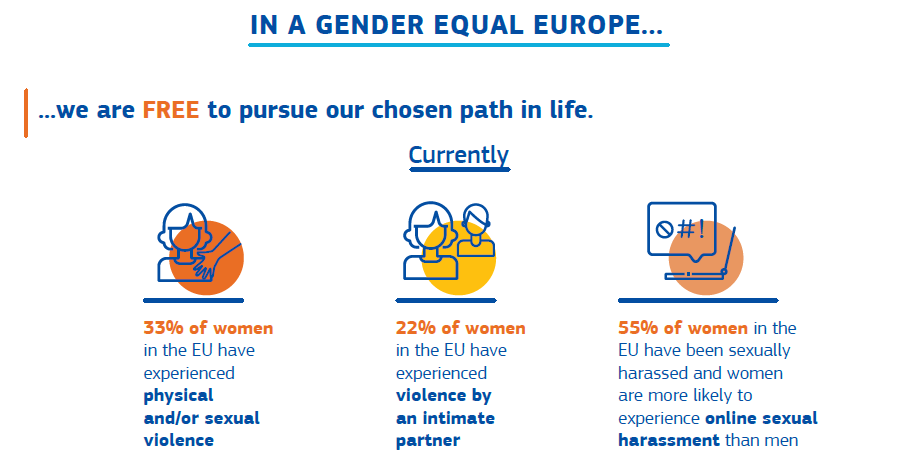What can education do to fight for gender equality?
The 8th of March is celebrated almost all around the globe as the International Women’s Day (IWD). Generally considered by most people as a day of celebration, in reality, the objective of this recurrence is to assess the situation in terms of fighting for women’s rights and for ending gender inequalities. Already in 1921, the idea of using this date was considered by some countries to commemorate the Russian Women’s Day of 1917. However, it was only in 1977 that the United Nations officially recognised the 8th of March as International Women’s Day (Wolff 2020). Over the years, the global north has seen some improvements in the general living conditions of women. However, the situation still remains critical. In particular, the last years have seen a worsening in the protection of women’s rights: like the overturning of Roe vs. Wade in the US or the advancements of right-wing parties in national elections all across Europe. Acting in the field of Education is then crucial to educate future generations to prevent stereotypes and discriminations, and to offer equal chances to everyone.The current situation of instability requires even more attention and dedication when it comes to women’s rights and gender inequalities. This is why, this year at FREREF we are concentrating on the gender inequalities in Education in Europe.
The role of education in society is extremely important. Having access to a good education not only is a basic human right but is also a key aspect to improve one’s living conditions. However, not everyone can afford to have access to education and, still today, a lot of obstacles to its fruition are in place. The situation across Europe is very diversified, with some countries having a Gender Equality Index (GEI) close to a general condition of equality, while others are still slacking behind. When it comes to the European situation around education, saying that some countries are close to achieving equality is not technically true. However, the difference between countries is still reflected in this domain. The main issue in Europe is related to the concept of segregation in education. Generally, there is no obstacle for women when it comes to simple access to education. On the contrary, in most European countries it is possible to observe a higher percentage of women enrolled in university compared to men. According to the European Institute for Gender Equality, in 2022 it has been estimated that 27% of European women hold a University degree, while the male counterpart is 26%. Then, why are we talking about segregation? In this case, the term segregation is not used to describe the access to university, but rather the area of studies in which one gender is overrepresented. The focus is usually on the science, technology, engineering and mathematics (STEM) and the education, health and welfare (EHW) fields for opposite reasons: the former being highly dominated by men, while the latter by women. But how deeply rooted is this gap? Regarding the STEM field, we have used a site that has been monitoring the presence of women in STEM universities (Women in STEM statistics). Over the years the percentage of women in this area of study has been fluctuating around 25%, without ever surpassing the threshold of 26%. What further aggravates the situation is the even lower presence of women in the workplace: with some specific areas, like engineering, where women account only for 10% of the “workforce”. The trend is similar but in the opposite direction in the EHW field. The European Institute for Gender Equality has estimated that 43% of all the European women enrolled in university are studying subjects related to education, health and welfare, compared to only 21% of men. However, even in these sectors dominated by women, a problem still remains, and it is what we call the ‘glass ceiling’. The glass ceiling is a metaphor to describe the invisible barriers individuals face during their careers to advance to senior positions within an organisation (Bouronikos 2021). Still today, all across Europe, it is possible to find obstacles to the advancement of women in their working career. This is particularly true in the less developed areas of Europe, like Italy and Eastern Europe (Bouronikos 2021). In order to understand what measures can be adopted to reduce this separation, it is fundamental to understand the primary cause of segregation. In this case, society is playing an important role in maintaining these gender barriers. In fact, the social interaction that we observe on a daily basis can be considered the initial obstacle to gender equality. In most of the countries it is possible to experience a substantial difference in the way girls are raised compared to boys. This statement is supported by the fact that, statistically, we can observe an unequal involvement of women and men in care. The European average sees 38% of women conducting daily at least one activity related to care and education outside of paid work, while only 25% of men are doing that (CEPS 2016). However, if we take education out of the equation and focus only on the percentage of people doing houseworks, this gap becomes even bigger: 78.7% of women and 33.7% of men (CEPS 2016). If in some countries the task of taking care of the family and the house is mainly done by women, it is possible to understand why society has labelled this job as a female job. Hence, it is not too difficult to understand the reason behind the concentration of female students in those fields of studies related to the concept of care. On a similar note, the same argument can be raised regarding the predominance of men in scientific areas. For centuries these fields had been entirely reserved to men – with some rare exceptions. Nowadays, this clear cut is not in place anymore. However, due to the same factor previously named, the flow of women into this sector has been extremely slow and insufficient to counter the general trend.



Why is this topic so relevant? The achievement of gender equality is part of the Gender Equality Strategy of the European Union for 2020-2025. In this strategy all the issues that we have previously mentioned are considered an obstacle for the achievement of gender equality. What is particularly relevant is the willingness to act at all possible levels, in order to finally reach gender equality. In this sense, we have already stated that education plays a fundamental role in society and, funnily enough, the solution to the problem we have raised can be found inside the problem itself. In order to eliminate the existing segregation inside education, we must change the way in which we are educating people. However, focusing solely on children’s education might not be enough to reach the objective of equality. The process of educating someone is extremely complex and cannot be pinned entirely to the schools. In fact, as we know, part of it is conducted, deliberately or not, inside the house. Therefore, changing the educational system without trying to change the society in which we are living, might be only causing some behavioural conflicts. Over the years, at FREREF we had the opportunity to acknowledge the importance of not limiting the concept of education to just the scholar phase. This is why we believe in the notion of Lifelong Learning because we never stop to learn. For this important occasion, we have decided to support the fight for gender equality in the field that we know best: education.
Pictures credit : Gender equality Strategy Factsheet
Author : Enrico Fabris



